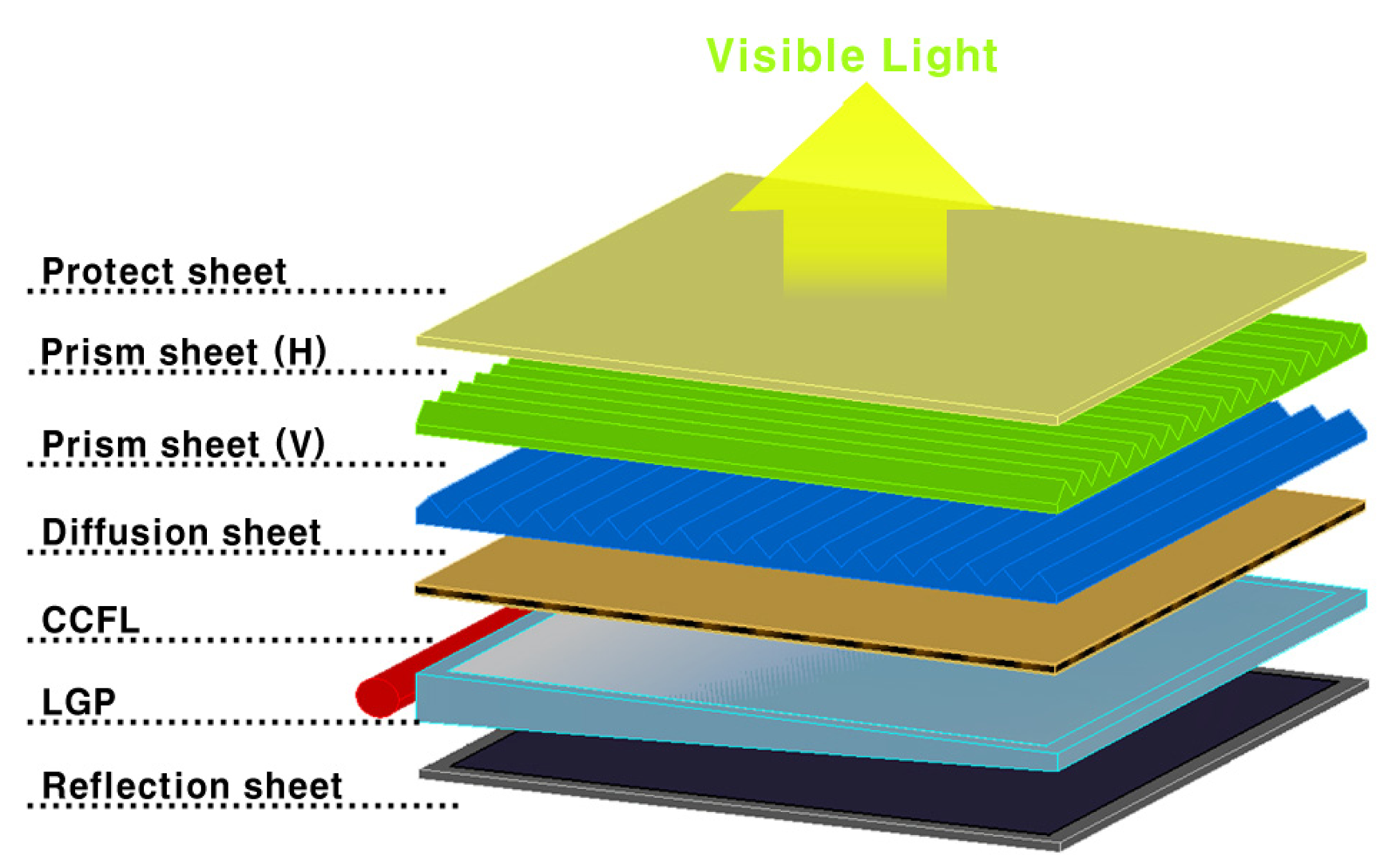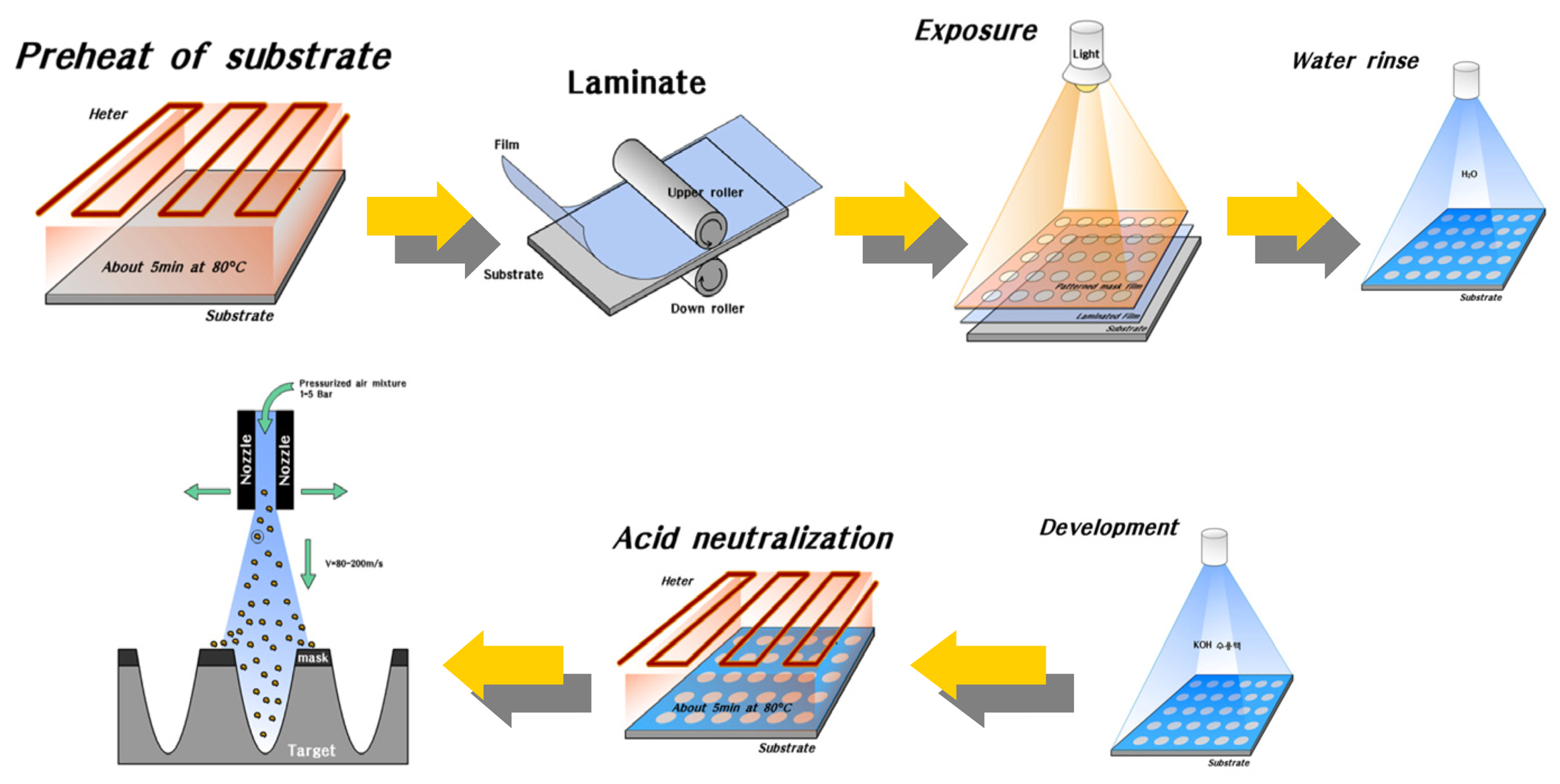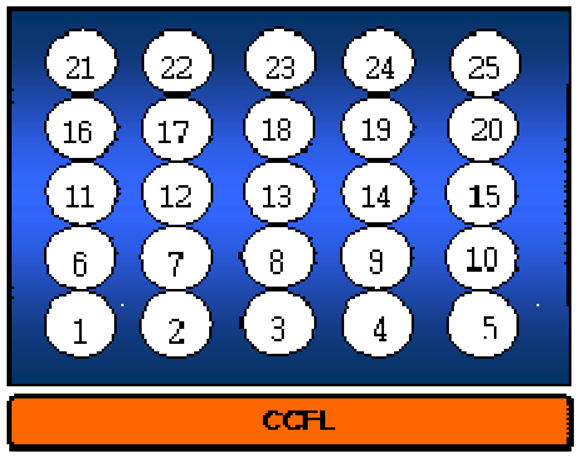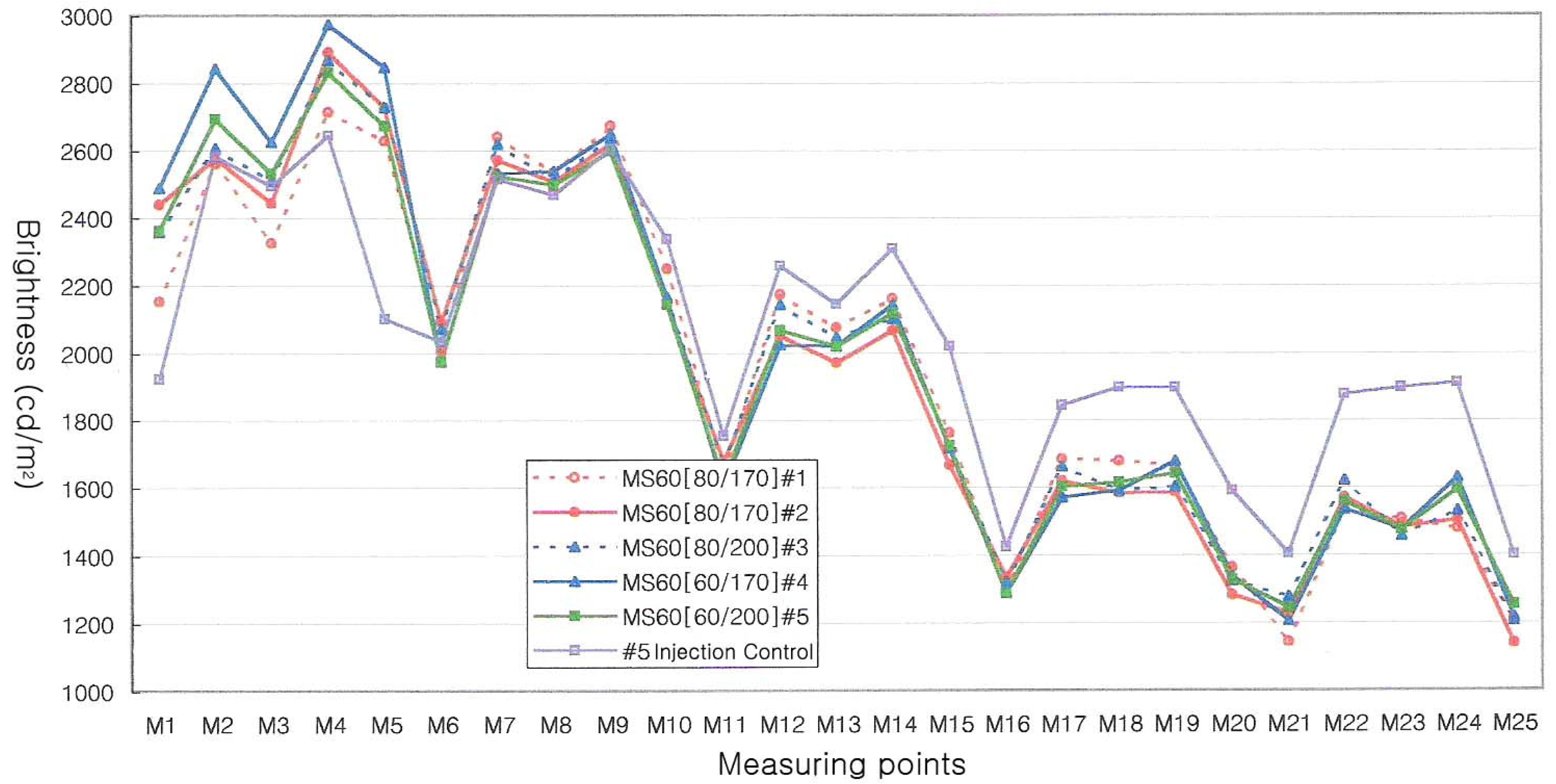Micro Dot Patterning on the Light Guide Panel Using Powder Blasting
Abstract
:1. Introduction
2. Basic structure of a light guide panel
2.1 Components of a TFT-LCD
2.2 Existing dot pattern making processes
- (a)
- Screen printing : This is the most generally adopted method for micro pattern formation on LGPs. Patterns are formed using a screen printing method on a PMAA panel with ink(SiO2, Al2O3, TiO2, etc.). Pattern height can be controlled by the numbers of screen printing. This method has advantages of short developing time, high productivity and low cost and disadvantages of low brightness compared to other methods.
- (b)
- Injection using etched mold : In this method, patterns are formed on the mold by chemical etching. Using the etched mold, patterns can then be formed on the LGP via an injection process. Etched depth varies according to the concentration of chemical solution and etching time. Since it is difficult to control the etched depths, this method has some disadvantages including difficulties to produce uniform molds, irregular light dispersion, and ejection problems caused by over-etching.
- (c)
- Mechanical machining : This method uses machine tools to form micro grooves on a flat type LGP. Brightness can be controlled by the groove density on the LGP. Grooves can be machined either on the LGP directly or on a mold. While this method can deliver high brightness, long machining time is required. Other drawbacks are that groove depth control is difficult due to tool wear and deformation can occur due to applied mechanical force.
- (d)
- Injection using abrasive jet machined mold : This method adopts micro abrasive jet machining techniques to form patterns on the LGP mold. Several research results have been reported for limited cases; however, only a few practical application cases have been reported thus far. This method is expected to offer high productivity.
3. Mold machining process conditions
3.1 Machining properties of micro powder blasting
3.2 Applied machining process
4. Machining results and analysis
4.1 Specimen shapes after masking
4.2 Powder blasted mold analysis
4.3 Shape analysis of injected LGP
5. Matte finishing and results analysis
5.1 Shape analysis of matte finished mold surface
5.2 Performance analysis of the LGP injected by a matte finished mold
6. Conclusion
- (1)
- A masking process for a LGP mold entailing laminating, exposure, and developing has been established.
- (2)
- LGP molds with micro pattern could be effectively machined by adopting a micro powder blasting technique, producing a prototype LGP successfully.
- (3)
- From the shape analysis and comparison of micro dot patterns on the injected LGP with those on the developed injection mold, good transcription of micro patterns was observed.
- (4)
- Matte finishing was successfully applied to the mold surface to improve the diffusion characteristics and brightness of the emitting light from LGPs.
- (5)
- From the results of this study, it can be concluded that the proposed method can be implemented successfully to form micro patterns on a LGP and thereby replace existing screen printing method.
References
- Slikkerveer, P. J.; Bouten, P. C. P.; de Haas, F. C. M. High quality mechanical etching of brittle materials by powder blasting. Sensors and actuators A: Physical 2000, 85, 296–303. [Google Scholar]
- Wensink, H.; Berenschot, J. W.; Jansen, H. V.; Elwenspoek, M. C. High resolution powder blast micromaching. Proceedings IEEE Thirteenth Annual International Conference on Micro Electro Mechanical Systems 2000, 769–774. [Google Scholar]
- Ligthart, H. J.; Slikkerveer, P. J. Glass and glass machining in Zeus panels. Philips journal of research 1996, 50, 475–499. [Google Scholar]
- Izawa, M. The trend and application of the abrasive jet machining. Journal of the Society of Grinding Engineers 2000, 44(1), 11–14. [Google Scholar]
- Solignac, D.; Sayah, A.; Constantin, S.; Freitag, R.; Gijs, M. A. M. Powder blasting for the realisa-tion of microchips for bio-analytic applications. Sensors and actuators A: Physical 2001, 86, 1–6. [Google Scholar]
- Kim, K. H.; Park, D. S. Effect of impact angle on the erosion of glass in powder blasting. Proceedings of Asia-Pacific Forum on Precision Surface Finishing Technology Nov. 21-23 Singapore 2001, 175–184. [Google Scholar]
- Park, D. S.; Cho, M. W.; Lee, H.; Cho, W. S. Micro-grooving of glass using micro-abrasive jet machining. Journal of materials processing technology 2004, 146(2), 234–240. [Google Scholar]
- Park, D. S.; Cho, M. W.; Lee, H. Effects of the impact angle variations on the erosion rate of glass in powder blasting process. International journal of advanced manufacturing technology 2004, 23, 444–450. [Google Scholar]
- Cho, M. W.; Kim, D. W.; Lee, E. S.; Cho, W. S.; Lee, J.; Park, D. S.; Seo, T. I. Machinability evaluation of Si3N4-hBN composites for micro pattern making processes. Key Engineering Materials 2004, 264-268, 869–872. [Google Scholar]









| Abrasive(powder) | WA #800 |
| Blasting pressure | 0.25MPa |
| Mass flow rate of abrasive | 80-150g/min |
| Impact angle of abrasive | 90° |
| X-directional feed of table | 50mm/sec |
| Y-directional feed of table | 100mm/sec |
| Standoff distance | 100mm |
© 2008 by MDPI Reproduction is permitted for noncommercial purposes.
Share and Cite
Jang, H.S.; Cho, M.W.; Park, D.S. Micro Dot Patterning on the Light Guide Panel Using Powder Blasting. Sensors 2008, 8, 877-885. https://doi.org/10.3390/s8020877
Jang HS, Cho MW, Park DS. Micro Dot Patterning on the Light Guide Panel Using Powder Blasting. Sensors. 2008; 8(2):877-885. https://doi.org/10.3390/s8020877
Chicago/Turabian StyleJang, Ho Su, Myeong Woo Cho, and Dong Sam Park. 2008. "Micro Dot Patterning on the Light Guide Panel Using Powder Blasting" Sensors 8, no. 2: 877-885. https://doi.org/10.3390/s8020877




